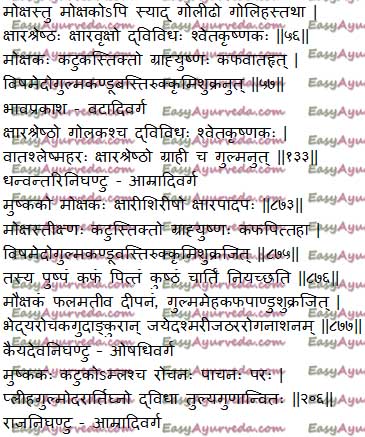Moshka (Schrebera swietenioides) – Uses, Remedies, Research, Side Effects
Dr Renita D’Souza
Moksha (Schrebera swietenioides) is an Ayurvedic medicinal tree used traditionally in the treatment of skin diseases, diabetes, urinary disorders, indigestion, intestinal worm infestation, poisoning, gulma etc. As the wood of the tree is used by weavers to make the beam of the looms, the tree is commonly called as Weaver’s Beam Tree. It is a good carminative and digestive agent.
Table of Contents
Introduction
Botanical Name – Schrebera swietenioides
Family – Oleaceae
Medicinal Qualities
Taste – Pungent (katu), Bitter (tiktha)
Virya (potency) – Hot (ushna)
Qualities –
Grahi – absorbent in nature
Tikshna – penetrating, sharp in nature
Effect on Tridoshas
Balances Kapha and Vata dosha
Qualities of flower, fruits
Qualities of Flowers of Mushkaka
Balances Kapha and Pitta dosha.
Used in the treatment of skin diseases and relieves pain.
Balances Kapha and Pitta dosha.
Used in the treatment of skin diseases and relieves pain.
Qualities of Moksha Fruit
Balances Kapha dosha.
It is carminative, spermicidal (shukranuth), laxative (bhedya)
Used in the treatment of gulma (abdominal tumour), Meha (diabetes), Pandu (anaemia), anorexia, piles, renal calculi and digestive problems.
Traditional Uses
Visha – poisoning, toxic conditions
Meda – diseases related to fat tissue, obesity
Gulma – abdominal tumour
Kandu – itching
Basti ruk – diseases related to urinary bladder
Krimi – worm infestation
Shukra nuth – spermicidal
Phliha – spleen disorders
Udara – ascites
Morphology
Schrebera swietenioides is a deciduous medium sized tree growing up to 15-20 meter tall. Leaves compound, imparipinnate, opposite. Leaflets 7-9, oppositie, elliptic-lanceolate, ovate. Flowers fragrant at night, yellowish brown in colour. Fruit capsule, obovoid, pear shaped. Seeds many, flat, winged.
Traditional Remedies of Muskaka
- Medicinal ghee prepared from its roots is used in skin diseases.
- Alkali (kshara) prepared from this plant is considered as the best and used in diseases related to oral cavity and grahani (malabsorption, IBS)
- Its fruits are tied to the waist of children with hydrocele .
Part Used
Roots, Bark, Leaves, Fruits, Alkali
Names in different languages
English Name – Weaver’s Beam Tree
Hindi Name – Mokha, Ekasira, Banpalas, Mokhdi,
Bengali Name – Ghanta paarul
Marathi Name – Mokhada, Mokha, Mokadi, Nakti
Kannada Name – Bula, Gante, Mogalinga mara
Tamil Name – Magalingam, Kattupparutticceti, Mogalingam, Makalinkam
Malayalam Name – Maggamaram, Malamplasu, Muskkakavrksam
Telugu Name – Magalinga, Bullakaya, Tondamukkudi
Oriya Name – Mokka

Distribution
Schrebera swietenioides is found in India, Bangladesh, Myanmar, Thailand, Cambodia and Laos.
Ayurvedic medicines with Mushka as Ingredient
Krimighna Vatika – It is used in the treatment of intestinal worms and parasites.
Ayaskriti – It is a Liquid Ayurvedic medicine mainly used in anemia, weight loss therapy, skin diseases, diabetes, Intestinal worms, IBS, Obesity etc
Sanskrit Synonyms
Moksha, Mokshaka,
Golidha, Goliha, Golika
Kshara streshta – Alkali (kshara) prepared of this plant is considered as of good quality.
Kshara vriksha
Mushkaka, Mushtirmushaka, Munchaka
Golaka, Ksharishirisha,
Ksharapadapa, Mushika
Gantapatali, Kshudrapatali
Side Effects of Mokshaka
There are no recorded side effects.
However, in high oral dosage can cause stomach irritation, burning sensation, constipation due to its tikshna, hot and grahi quality.
Due to its shuranuth (spermicidal) quality, it is best to avoid its usage in the person with low sperm count.
It is better to consult doctor for its usage during pregnancy, lactation and in children.
Interaction with medicines, supplements
Can this be used while taking Homeopathic medicine?
Yes. This product does not react with homeopathic medicine.
Can
this medicine be continued while taking supplements like multivitamin tablets,
Omega 3 fatty acids etc?
Yes. Generally, this product goes well with most
of the dietary supplements. However, if you are taking more than one product
per day, please consult your doctor for an opinion.
With western
medicines
Seek your
doctor’s advice if you are taking this product along with other western
(allopathic / modern) medicines. Some Ayurvedic herbs can interact with modern
medicine.
If both Ayurvedic and allopathic medicines are advised together, then it is
best to take Allopathic medicine first, wait for 30 minutes and then take the
Ayurvedic medicine.
Research
Anti diabetic Activity – A study done to evaluate anti diabetic and antioxidant effect of ethenolic extract of fruit of Schrebera swietenioides has concluded that ethenolic extract of fruit of Schrebera swietenioides and Glibenclamide exhibited remarkable blood glucose lowering effect in glucose tolerance test.
Two Varieties of Moksha
1. Shwetha (white variety) – Schrebera swietenioides
2. Krishna (black variety) – Elaeodendron glaucum
Mokshaka is usually referred to white variety (Schrebera swietenioides).
Classical Categorisation
Bhavaprakasha Nighantu – Vataadi Varga
Dhanvantari Nighantu – Amraadi Varga
Kaiyadeva Nighantu – Aushadi Varga
Raja Nighantu – Amradi Varga
Shodala Nighantu – Amradi Varga
Click to Consult Dr Renita D’Souza









